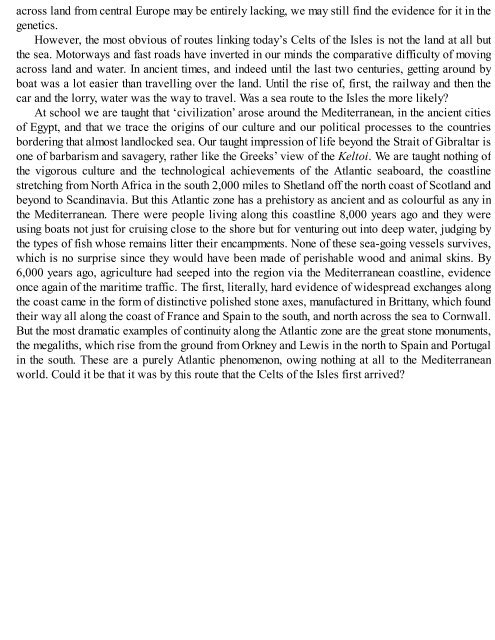You also want an ePaper? Increase the reach of your titles
YUMPU automatically turns print PDFs into web optimized ePapers that Google loves.
across land from central Europe may be entirely lacking, we may still find the evidence for it in the<br />
genetics.<br />
However, the most obvious of routes linking today’s Celts of the Isles is not the land at all but<br />
the sea. Motorways and fast roads have inverted in our minds the comparative difficulty of moving<br />
across land and water. In ancient times, and indeed until the last two centuries, getting around by<br />
boat was a lot easier than travelling over the land. Until the rise of, first, the railway and then the<br />
car and the lorry, water was the way to travel. Was a sea route to the Isles the more likely?<br />
At school we are taught that ‘civilization’ arose around the Mediterranean, in the ancient cities<br />
of Egypt, and that we trace the origins of our culture and our political processes to the countries<br />
bordering that almost landlocked sea. Our taught impression of life beyond the Strait of Gibraltar is<br />
one of barbarism and savagery, rather like the Greeks’ view of the Keltoi. We are taught nothing of<br />
the vigorous culture and the technological achievements of the Atlantic seaboard, the coastline<br />
stretching from North Africa in the south 2,000 miles to Shetland off the north coast of Scotland and<br />
beyond to Scandinavia. But this Atlantic zone has a prehistory as ancient and as colourful as any in<br />
the Mediterranean. There were people living along this coastline 8,000 years ago and they were<br />
using boats not just for cruising close to the shore but for venturing out into deep water, judging by<br />
the types of fish whose remains litter their encampments. None of these sea-going vessels survives,<br />
which is no surprise since they would have been made of perishable wood and animal skins. By<br />
6,000 years ago, agriculture had seeped into the region via the Mediterranean coastline, evidence<br />
once again of the maritime traffic. The first, literally, hard evidence of widespread exchanges along<br />
the coast came in the form of distinctive polished stone axes, manufactured in Brittany, which found<br />
their way all along the coast of France and Spain to the south, and north across the sea to Cornwall.<br />
But the most dramatic examples of continuity along the Atlantic zone are the great stone monuments,<br />
the megaliths, which rise from the ground from Orkney and Lewis in the north to Spain and Portugal<br />
in the south. These are a purely Atlantic phenomenon, owing nothing at all to the Mediterranean<br />
world. Could it be that it was by this route that the Celts of the Isles first arrived?
















